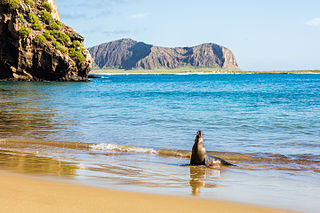Tortuga, Tortuga Isle, or Tortuga Island may refer to:

Hispaniola is an island in the Caribbean that is part of the Greater Antilles. Hispaniola is the most populous island in the West Indies, and the region's second largest in area, after the island of Cuba.

The Galápagos Islands are an archipelago of volcanic islands. They are distributed on each side of the equator in the Pacific Ocean, surrounding the centre of the Western Hemisphere, and are part of the Republic of Ecuador. Located 900 kilometres west of continental Ecuador, the islands are known for their large number of endemic species that were studied by Charles Darwin during the second voyage of HMS Beagle in the 1830s. His observations and collections contributed to the inception of Darwin's theory of evolution by means of natural selection.

The Antilles is an archipelago bordered by the Caribbean Sea to the south and west, the Gulf of Mexico to the northwest, and the Atlantic Ocean to the north and east.

Nord-Ouest (French) or Nòdwès is one of the ten departments of Haiti as well as the northernmost one. It has an area of 2,102.88 km2 (811.93 sq mi) and a population of 728,807. Its capital is Port-de-Paix.

Tortuga Island is a Caribbean island that forms part of Haiti, off the northwest coast of Hispaniola. It constitutes the commune of Île de la Tortue in the Port-de-Paix arrondissement of the Nord-Ouest department of Haiti.
Culpeper or Culpepper may refer to:
The music of the Cayman Islands, a Caribbean island chain, includes a wide selection of international pop music as well as unique folk styles. The Cayman National Cultural Foundation, established in 1984, helps to preserve and promote Cayman folk music, including the organisation of festivals such as Cayman Islands International Storytelling Festival, the Cayman JazzFest, Seafarers Festival and Cayfest. There is also a Pirate's Week Festival. The Cayman JazzFest, founded in 2004, is a well-known jazz festival, that draws on the islands' "deep connection" with jazz.
Turtle Island may refer to:

Santa Cruz Island is the most populous and second-largest islands in the Galapagos Archipelago in Ecuador. Situated in the middle of the group, Santa Cruz is a shield volcano with an area of 986 km2 (381 sq mi) and a maximum altitude of 864 m (2,835 ft). It has a population around 18,000, its largest settlement and seat of government being Puerto Ayora. There are also some small villages, whose inhabitants work in agriculture and cattle raising.
Tortuga is the Spanish word for a turtle or tortoise. It may also refer to:

Galápagos National Park was established in 1959. It began operation in 1968, and it is Ecuador's first national park and a UNESCO World Heritage Site.

Edward Davis or Davies was an English buccaneer active in the Caribbean during the 1680s and would lead successful raids against Leon and Panama in 1685, the latter considered one of the last major buccaneer raids against a Spanish stronghold. Much of his career was later recorded by writer William Dampier in A New Voyage Round the World (1697).
Jacquotte Delahaye was a purported pirate of legend in the Caribbean Sea. She has been depicted as operating alongside Anne Dieu-le-Veut as one of very few 17th-century female pirates. There is no evidence from period sources that Delahaye was a real person. Stories of her exploits are attributed to oral storytelling and Leon Treich, a French fiction writer of the 1940s.

Pieter Adriaanszoon Ita was a 17th-century Dutch privateer. He was also an admiral in the Dutch West India Company and, in 1628, commanded a large expedition against Portuguese and Spanish interests in the Caribbean. The expedition was one of the largest of its time and included many of the great privateers of the era.
Pieter Schouten was a 17th-century Dutch corsair and privateer. He was one of the first Dutchmen to explore to the Caribbean and, while employed by the Dutch West Indies Company, was involved in extensive reconnaissance to establish Dutch bases in the West Indies.
Tortuga Bay is located on the Santa Cruz Island, about a 20-minute water-taxi ride from the main water taxi dock in Puerto Ayora. There is also a walking path, which is 1.55 miles (2,490 m) and is open from six in the morning to six in the evening. Visitors must sign in and out at the start of the path with the Galapagos Park Service office. Tortuga Bay has a gigantic, perfectly preserved beach that is forbidden to swimmers and is preserved for the wildlife where many marine iguanas, galapagos crabs and birds are seen dotted along the volcanic rocks. There is a separate cove where you can swim where it is common to view white tip reef sharks swimming in groups and on occasion tiger sharks
White Haitians, also known as Euro-Haitians, are Haitians of predominant or full European descent.